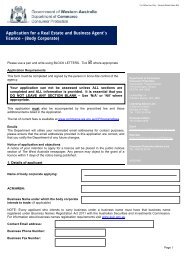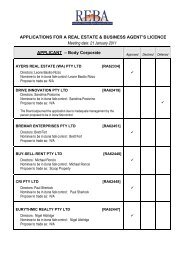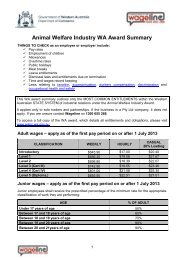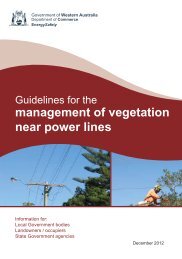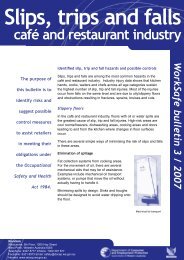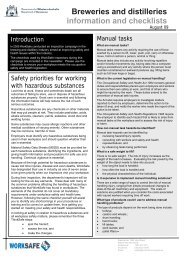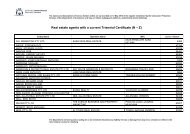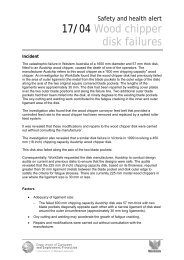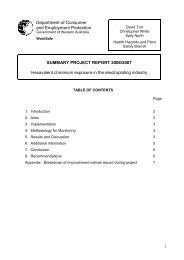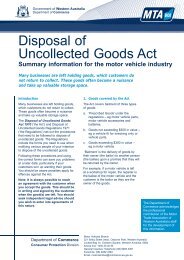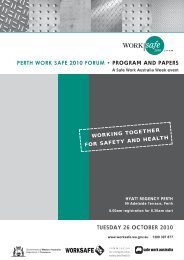manual tasks in supermarkets - Department of Commerce
manual tasks in supermarkets - Department of Commerce
manual tasks in supermarkets - Department of Commerce
You also want an ePaper? Increase the reach of your titles
YUMPU automatically turns print PDFs into web optimized ePapers that Google loves.
Introduction<br />
Manual <strong>tasks</strong> <strong>in</strong> Supermarkets<br />
<strong>in</strong>formation and checklist<br />
In 2011 WorkSafe conducted an enforcement campaign deal<strong>in</strong>g with <strong>manual</strong> task issues <strong>in</strong> <strong>supermarkets</strong>. As part <strong>of</strong> this campaign<br />
the follow<strong>in</strong>g newsletter was developed to outl<strong>in</strong>e the <strong>manual</strong> <strong>tasks</strong> issues which can be present <strong>in</strong> <strong>supermarkets</strong>.<br />
Also <strong>in</strong>cluded are the checklists used by WorkSafe <strong>in</strong>spectors dur<strong>in</strong>g this campaign. Please use these checklists to ensure your<br />
workplace meets with the Occupational Safety and Health legislation<br />
What are the issues<br />
A checklist has been developed which may assist you assess<br />
your workplace for hazards related to <strong>manual</strong> <strong>tasks</strong>. This<br />
checklist is <strong>in</strong>cluded <strong>in</strong> this publication (from page five<br />
onwards). Issues covered by the checklist <strong>in</strong>clude:<br />
• Manual <strong>tasks</strong> tra<strong>in</strong><strong>in</strong>g<br />
• Systems for <strong>manual</strong> <strong>tasks</strong><br />
• Equipment – steps, ladders and trolleys<br />
• Equipment – forklifts and pallet jacks<br />
• Load<strong>in</strong>g docks<br />
• Rear stores area<br />
• Rear cool rooms<br />
• Front <strong>of</strong> store/ shelv<strong>in</strong>g<br />
• Checkout work areas<br />
• General access/ egress and environment<br />
• Other issues<br />
Further <strong>in</strong>formation can be obta<strong>in</strong>ed by contact<strong>in</strong>g WorkSafe on<br />
9327 8777 or by visit<strong>in</strong>g the website: www.worksafe.wa.gov.au<br />
How do I use these checklists?<br />
What are <strong>manual</strong> <strong>tasks</strong>?<br />
Manual <strong>tasks</strong> refer to any activity that requires a person to use<br />
their physical body (musculoskeletal system) to perform work. It<br />
<strong>in</strong>cludes <strong>manual</strong> handl<strong>in</strong>g (the use <strong>of</strong> force <strong>in</strong> lift<strong>in</strong>g, lower<strong>in</strong>g,<br />
push<strong>in</strong>g, pull<strong>in</strong>g, carry<strong>in</strong>g or otherwise mov<strong>in</strong>g, hold<strong>in</strong>g or<br />
restra<strong>in</strong><strong>in</strong>g any person, animal or th<strong>in</strong>g); repetitive actions;<br />
adopt<strong>in</strong>g awkward or susta<strong>in</strong>ed postures and <strong>tasks</strong> that expose<br />
workers to vibration.<br />
What is a risk assessment?<br />
The occupational safety and health laws require risk<br />
assessments to be carried out.<br />
A risk assessment is the process <strong>of</strong> determ<strong>in</strong><strong>in</strong>g whether there<br />
is a risk associated with an identified hazard, that is, whether<br />
there is any likelihood <strong>of</strong> <strong>in</strong>jury or harm. The process should<br />
<strong>in</strong>clude consultation with people <strong>in</strong>volved <strong>in</strong> the task, as well as<br />
consideration <strong>of</strong> the, experience and tra<strong>in</strong><strong>in</strong>g <strong>of</strong> the operator,<br />
<strong>in</strong>dividual <strong>tasks</strong> to be performed and the length <strong>of</strong> time the<br />
operator is exposed to the identified hazards.<br />
1. Use the checklists <strong>in</strong> this newsletter to <strong>in</strong>spect your workplace. You may see other hazards as you are go<strong>in</strong>g through – add them to<br />
the checklist.<br />
2. Anyth<strong>in</strong>g that you have ticked ‘No’ or added to the list needs to be fixed. So, look at each hazard us<strong>in</strong>g the table below to prioritise<br />
identified hazards.<br />
Risk rat<strong>in</strong>g table – for work<strong>in</strong>g out level <strong>of</strong> risk Use the vertical and horizontal columns to consider both the likelihood <strong>of</strong> <strong>in</strong>jury or<br />
harm to health and the consequences to work out the level <strong>of</strong> risk<br />
Likelihood <strong>of</strong> <strong>in</strong>jury or<br />
harm to health<br />
Consequences <strong>of</strong> any <strong>in</strong>juries or harm to health<br />
Insignificant eg no <strong>in</strong>juries Moderate eg first aid Major eg extensive <strong>in</strong>juries Catastrophic eg death<br />
Very likely High Extreme Extreme Extreme<br />
Likely Moderate High Extreme Extreme<br />
Moderate Low High Extreme Extreme<br />
Unlikely Low Moderate High Extreme<br />
Highly unlikely (rare) Low Moderate High High<br />
Risk assessment is a 'best estimate' on the basis <strong>of</strong> available <strong>in</strong>formation. It is important the responsible person undertak<strong>in</strong>g a risk assessment has<br />
the necessary <strong>in</strong>formation, knowledge and experience <strong>of</strong> the work environment and work process, or such a person is <strong>in</strong>volved.<br />
3. If the hazard falls <strong>in</strong>to ‘high’ or ‘extreme’, based on your view <strong>of</strong> how likely it is someone will get hurt and what level <strong>of</strong> <strong>in</strong>jury could<br />
happen, then you need to fix it straight away.<br />
If it is lower down <strong>in</strong> the table – moderate or low – then plan when you will fix it.<br />
Remember hazards have to be controlled – you can’t ignore them.<br />
Westcentre 1260 Hay Street<br />
West Perth WA 6005<br />
Telephone: 1300 307 877<br />
Facsimile: (08) 9321 8973<br />
Email: safety@commerce.wa.gov.au
Risks<br />
What <strong>in</strong>juries can result from <strong>manual</strong><br />
<strong>tasks</strong>?<br />
Workplace <strong>in</strong>juries most commonly l<strong>in</strong>ked to <strong>manual</strong> <strong>tasks</strong> <strong>in</strong>clude<br />
spra<strong>in</strong>s and stra<strong>in</strong>s (most commonly <strong>of</strong> the muscles, ligaments and<br />
tendons support<strong>in</strong>g the shoulders, back and neck); hernias; and<br />
disc <strong>in</strong>juries to the sp<strong>in</strong>e. Such <strong>in</strong>juries are a major cause <strong>of</strong> lost<br />
time at work.<br />
Injuries can be the result <strong>of</strong> gradual wear and tear (eg from<br />
frequent or prolonged <strong>manual</strong> <strong>tasks</strong> over a period <strong>of</strong> time), or<br />
sudden damage (eg from a s<strong>in</strong>gle lift <strong>of</strong> someth<strong>in</strong>g very heavy or<br />
awkward to handle, or from an unexpected event that result <strong>in</strong><br />
<strong>in</strong>jury (eg a worker trips and falls while carry<strong>in</strong>g a large, heavy<br />
carton).<br />
In the 2008-2009 f<strong>in</strong>ancial year, workers compensation claims from<br />
<strong>in</strong>juries that resulted from “body stress<strong>in</strong>g” made up 37.6% <strong>of</strong> all<br />
lost time claims <strong>in</strong> WA, with an average lost time duration <strong>of</strong> 90.5<br />
days. When <strong>manual</strong> task <strong>in</strong>jury data is comb<strong>in</strong>ed with slips, trips<br />
and falls <strong>in</strong>jury data, the supermarket <strong>in</strong>dustry accounts for higher<br />
numbers <strong>of</strong> lost time <strong>in</strong>juries to sales assistants and storepersons<br />
than any other <strong>in</strong>dustry <strong>in</strong> WA.<br />
How do I reduce the risk <strong>of</strong> <strong>in</strong>jury<br />
from <strong>manual</strong> <strong>tasks</strong>?<br />
The first step, <strong>in</strong> consultation with your workers, is to identify the<br />
<strong>manual</strong> task hazards for your workplace. This can be done via<br />
complet<strong>in</strong>g workplace walk-throughs or <strong>in</strong>spections to identify<br />
hazards; analysis <strong>of</strong> past hazard and <strong>in</strong>cident forms and previous<br />
<strong>in</strong>jury records; talk<strong>in</strong>g with workers about <strong>tasks</strong> they f<strong>in</strong>d difficult or<br />
demand<strong>in</strong>g; and observ<strong>in</strong>g staff while they complete common <strong>tasks</strong><br />
to collect <strong>in</strong>formation.<br />
Next, <strong>in</strong> consultation with workers, identify trends and determ<strong>in</strong>e<br />
which <strong>tasks</strong> are higher risk/priority. For each task, complete a risk<br />
assessment to identify which risk factors are present for that task.<br />
Risk factors may be actions & postures; forces & loads; vibration;<br />
work environment; systems <strong>of</strong> work; and worker characteristics –<br />
please refer to the WA Manual Tasks Code <strong>of</strong> Practice (2010)<br />
available on the WorkSafe website for more <strong>in</strong>formation. The risk<br />
assessment should also determ<strong>in</strong>e what consequences/harm may<br />
result from perform<strong>in</strong>g that task, and how likely it is that this harm<br />
occurs.<br />
F<strong>in</strong>ally, for each hazard, determ<strong>in</strong>e what controls are needed to<br />
m<strong>in</strong>imise risk.<br />
Controll<strong>in</strong>g risks<br />
Controll<strong>in</strong>g the risk <strong>of</strong> <strong>in</strong>jury may <strong>in</strong>volve:<br />
2<br />
Where does the risk for<br />
<strong>manual</strong> <strong>tasks</strong> come from?<br />
The risks for <strong>manual</strong> <strong>tasks</strong> <strong>in</strong> <strong>supermarkets</strong> come<br />
from a range <strong>of</strong> sources <strong>in</strong>clud<strong>in</strong>g:<br />
1. work area design and layout (eg conf<strong>in</strong>ed<br />
spaces, storage <strong>of</strong> heavy items on high or low<br />
shelves)<br />
2. the nature <strong>of</strong> the item, equipment or tool (eg<br />
trolleys that are not appropriate for the task or<br />
are poorly ma<strong>in</strong>ta<strong>in</strong>ed mak<strong>in</strong>g them difficult to<br />
push/pull)<br />
3. the nature <strong>of</strong> the load (eg heavy boxes, bulky or<br />
awkward stock)<br />
4. the work<strong>in</strong>g environment (eg cool temperatures<br />
<strong>in</strong> freezers or cool rooms)<br />
5. systems <strong>of</strong> work, work organisation and work<br />
practices (eg repetitive <strong>tasks</strong>, <strong>in</strong>adequate breaks<br />
or task variety, unreasonable timeframes/<br />
workload).<br />
What are the most common <strong>manual</strong><br />
task risk factors for supermarket<br />
workers?<br />
The most common risk factors encountered <strong>in</strong><br />
<strong>manual</strong> <strong>tasks</strong> performed by supermarket workers<br />
(although it will vary between the various job roles)<br />
<strong>in</strong>clude:<br />
• handl<strong>in</strong>g heavy, bulky or awkward loads<br />
• hold<strong>in</strong>g loads/ arms away from trunk<br />
• twist<strong>in</strong>g back, neck or upper body<br />
• reach<strong>in</strong>g and load handl<strong>in</strong>g at low levels<br />
and above shoulder height<br />
• repetitive movements<br />
• strenuous lift<strong>in</strong>g, lower<strong>in</strong>g, carry<strong>in</strong>g, push<strong>in</strong>g<br />
and pull<strong>in</strong>g<br />
• load handl<strong>in</strong>g on one side<br />
• susta<strong>in</strong>ed and repetitive gripp<strong>in</strong>g<br />
• <strong>in</strong>adequate task variety or breaks<br />
• work<strong>in</strong>g under time pressures<br />
• work<strong>in</strong>g <strong>in</strong> cold environments<br />
• postural or movement constra<strong>in</strong>ts due to<br />
work<strong>in</strong>g <strong>in</strong> narrow or obstructed work areas<br />
1. elim<strong>in</strong>at<strong>in</strong>g the hazard or hazardous task<br />
2. re-design<strong>in</strong>g, modify<strong>in</strong>g, alter<strong>in</strong>g or substitut<strong>in</strong>g the hazard or hazardous task<br />
3. adm<strong>in</strong>istrative controls<br />
F<strong>in</strong>ally, when any control is implemented, make sure follow up and evaluation occurs to ensure that the control is adequately elim<strong>in</strong>at<strong>in</strong>g or<br />
m<strong>in</strong>imis<strong>in</strong>g the risk and has not <strong>in</strong>troduced new risks.
Elim<strong>in</strong>ate the hazard<br />
Controls<br />
3<br />
Controls that elim<strong>in</strong>ate the hazard <strong>in</strong>clude us<strong>in</strong>g automated equipment to move stock rather than <strong>manual</strong>ly<br />
mov<strong>in</strong>g stock. Options <strong>in</strong>clude:<br />
• conveyors at checkouts<br />
• forklifts to move pallets<br />
• automated pallet jacks or motorised trolleys that require guidance only<br />
• vacuum lifters or overhead lift<strong>in</strong>g hoists<br />
Re-design, modify or substitute<br />
Tasks can be redesigned, modified, altered or substituted to m<strong>in</strong>imise the risk <strong>of</strong> the <strong>manual</strong> task hazard. Controls that achieve this aim <strong>in</strong>clude:<br />
• Modify<strong>in</strong>g the work area and layout • Modify<strong>in</strong>g the work<strong>in</strong>g environment<br />
• Modify<strong>in</strong>g the items, equipment and tools • Modify<strong>in</strong>g systems <strong>of</strong> work, work organisation and work practices<br />
• Modify<strong>in</strong>g the load<br />
Modify<strong>in</strong>g the work<br />
area and layout<br />
Modify<strong>in</strong>g<br />
the load<br />
Modify<strong>in</strong>g<br />
the items,<br />
equipment &<br />
tools<br />
Modify<strong>in</strong>g the<br />
work<strong>in</strong>g<br />
environment<br />
Modify<strong>in</strong>g systems <strong>of</strong><br />
work, work<br />
organisation & work<br />
practices<br />
- redesign <strong>of</strong> workplace layout and systems to elim<strong>in</strong>ate double handl<strong>in</strong>g (eg us<strong>in</strong>g double sided upright<br />
dairy fridges, where newer stock is loaded from the rear, elim<strong>in</strong>at<strong>in</strong>g the need to remove older goods prior<br />
to stock<strong>in</strong>g for stock rotation)<br />
- redesign layout <strong>of</strong> storage areas both at front and rear <strong>of</strong> stores, so that heaviest items are stored<br />
between mid-thigh and chest height<br />
- improve access to pallets, so that pallets are accessible from every side, and use pallet stands or pallet<br />
lifters to raise the heights <strong>of</strong> pallets when handl<strong>in</strong>g stock at lower levels <strong>of</strong> the pallet<br />
- ensure adequate space to access shelv<strong>in</strong>g systems, cool rooms and equipment to m<strong>in</strong>imise twist<strong>in</strong>g or<br />
work <strong>in</strong> constra<strong>in</strong>ed postures<br />
- ensure that equipment is stored close to where it is needed to encourage use<br />
- where goods are provided by suppliers <strong>in</strong> large, awkward or heavy conta<strong>in</strong>ers/ bags, negotiate with<br />
suppliers for goods to be provided <strong>in</strong> smaller sizes/weights or more appropriate conta<strong>in</strong>ers (eg replac<strong>in</strong>g<br />
sacks with boxes/conta<strong>in</strong>ers with built <strong>in</strong> handles)<br />
- break goods down <strong>in</strong>to smaller loads prior to movement <strong>of</strong> goods<br />
- <strong>in</strong>stigate height and weight restrictions on trolleys (especially cage trolleys) to allow clear vision over<br />
trolleys and reduce strenuous push<strong>in</strong>g/ pull<strong>in</strong>g<br />
- ensure that the appropriate (type, size, numbers) equipment is available for use <strong>in</strong> <strong>manual</strong> <strong>tasks</strong> – eg<br />
steps, platform ladders and various trolleys<br />
- automate pallet jacks and trolleys so that strenuous push<strong>in</strong>g/ pull<strong>in</strong>g is not required<br />
- provide height adjustable work benches for produce, bakery, deli and butchers areas to accommodate<br />
different sized staff<br />
- modify checkout stations to provide both left and right hand stations, to reduce repetitive load on one<br />
side <strong>of</strong> the body<br />
- improve light<strong>in</strong>g, reduce noise and other distractions and ensure adequate ventilation<br />
- provide adequate space for handl<strong>in</strong>g objects (ie avoid over-order<strong>in</strong>g <strong>of</strong> stock, which impacts on<br />
ability to store and handle stock safely and leads to overcrowd<strong>in</strong>g <strong>of</strong> shelves and floor space)<br />
- ensure floor surfaces are ma<strong>in</strong>ta<strong>in</strong>ed <strong>in</strong> good, smooth and clean/ clear condition to facilitate<br />
effective use <strong>of</strong> trolleys and prevent slips/tips<br />
- provide anti-fatigue matt<strong>in</strong>g where workers stand for prolonged periods<br />
- provide adequate rest breaks; task variety; and rotation between <strong>tasks</strong> or work areas (eg between<br />
right and left hand checkouts, bulk checkouts and express lanes) to allow workers to use different<br />
actions and postures<br />
- ensure workloads are appropriate to physical capacity <strong>of</strong> workers, result<strong>in</strong>g <strong>in</strong> a safe work rate<br />
- space deliveries over the course <strong>of</strong> the week, so that there are not peaks <strong>in</strong> handl<strong>in</strong>g <strong>of</strong> <strong>in</strong>com<strong>in</strong>g<br />
goods on any one day or time <strong>of</strong> day<br />
- ensure appropriate staff<strong>in</strong>g levels at peak time periods<br />
- review if work<strong>in</strong>g hours are appropriate for the types <strong>of</strong> <strong>manual</strong> <strong>tasks</strong> be<strong>in</strong>g completed<br />
- ensure all equipment is regularly <strong>in</strong>spected, serviced and ma<strong>in</strong>ta<strong>in</strong>ed for cont<strong>in</strong>ued ease <strong>of</strong> use<br />
- <strong>in</strong>volve staff <strong>in</strong> selection <strong>of</strong> new equipment, and where possible, trial equipment prior to purchase
Adm<strong>in</strong>istrative controls<br />
Adm<strong>in</strong>istrative<br />
controls<br />
Other issues<br />
Tra<strong>in</strong><strong>in</strong>g <strong>in</strong> <strong>manual</strong> <strong>tasks</strong><br />
4<br />
- Adm<strong>in</strong>istrative controls are the last l<strong>in</strong>e <strong>of</strong> defence and should not be used as the primary or only<br />
control for <strong>manual</strong> task hazards. Adm<strong>in</strong>istrative controls <strong>in</strong>clude:<br />
- provision <strong>of</strong> tra<strong>in</strong><strong>in</strong>g, <strong>in</strong>formation and supervision<br />
- develop<strong>in</strong>g and enforc<strong>in</strong>g policies and procedures<br />
- provid<strong>in</strong>g personal protective equipment such as jackets and gloves for cool room work. (Please<br />
note: WorkSafe does NOT support the use <strong>of</strong> back braces for lift<strong>in</strong>g <strong>tasks</strong>. See our website for<br />
more <strong>in</strong>formation)<br />
Tra<strong>in</strong><strong>in</strong>g for <strong>manual</strong> <strong>tasks</strong> should <strong>in</strong>clude both<br />
theoretical and practical tra<strong>in</strong><strong>in</strong>g for<br />
supermarket workers, and should occur both at<br />
<strong>in</strong>duction for new staff, and on a regular (yearly)<br />
basis thereafter.<br />
Theoretical tra<strong>in</strong><strong>in</strong>g should cover a risk<br />
management approach, that is, workers should<br />
be able to identify <strong>manual</strong> task hazards, assess<br />
the risk <strong>of</strong> <strong>in</strong>jury from exposure to those<br />
hazards, and determ<strong>in</strong>e what controls are<br />
needed to m<strong>in</strong>imise the risk. When faced with<br />
their usual work <strong>tasks</strong>, this means that the<br />
worker should be able to identify those risk<br />
factors that may potentially make their work<br />
hazardous (for example, lift<strong>in</strong>g above chest<br />
height or prolonged stand<strong>in</strong>g). They should<br />
also know what processes to follow to report<br />
hazards, so that these can be addressed by<br />
management.<br />
Task specific tra<strong>in</strong><strong>in</strong>g might <strong>in</strong>clude <strong>in</strong>formation<br />
on prepar<strong>in</strong>g the environment for the <strong>manual</strong><br />
task; effective work<strong>in</strong>g postures; how to select<br />
and use equipment; and techniques tra<strong>in</strong><strong>in</strong>g <strong>in</strong><br />
lift<strong>in</strong>g, push<strong>in</strong>g/pull<strong>in</strong>g, carry<strong>in</strong>g and hold<strong>in</strong>g.<br />
More <strong>in</strong>formation on tra<strong>in</strong><strong>in</strong>g requirements is<br />
available <strong>in</strong> the Code <strong>of</strong> Practice: Manual<br />
Tasks (2010), available for free download from<br />
www.worksafe.wa.gov.au. WorkSafe also has<br />
a free <strong>manual</strong> handl<strong>in</strong>g tra<strong>in</strong><strong>in</strong>g package<br />
available for employers to modify, adopt and<br />
use as their own, also available for download<br />
through the website.<br />
Further <strong>in</strong>formation<br />
Dangerous Incident<br />
A 17 year old worker <strong>in</strong> the produce department <strong>of</strong> a supermarket<br />
susta<strong>in</strong>ed a significant back <strong>in</strong>jury from handl<strong>in</strong>g 20kg bags <strong>of</strong> onions.<br />
The bags were lifted from a pallet at floor level to a trolley and<br />
transported to the customer selection b<strong>in</strong>s. The bag would then be<br />
lifted <strong>in</strong>to the b<strong>in</strong>, before be<strong>in</strong>g cut open and emptied <strong>in</strong>to the b<strong>in</strong>. This<br />
task would be completed several times dur<strong>in</strong>g the course <strong>of</strong> a shift.<br />
There was no mechanical means <strong>of</strong> assistance provided to elim<strong>in</strong>ate the<br />
<strong>manual</strong> handl<strong>in</strong>g. The worker was not provided with adequate <strong>manual</strong><br />
handl<strong>in</strong>g tra<strong>in</strong><strong>in</strong>g (hav<strong>in</strong>g only watched an <strong>in</strong>duction video which conta<strong>in</strong>ed<br />
only a small section on lift<strong>in</strong>g). Formal risk assessments were not<br />
completed for <strong>manual</strong> <strong>tasks</strong> at the store, and store managers were not<br />
tra<strong>in</strong>ed <strong>in</strong> conduct<strong>in</strong>g hazard identification, risk assessment or control.<br />
The employer was convicted and f<strong>in</strong>ed $100 000 for fail<strong>in</strong>g to provide a safe<br />
workplace and meet their duty <strong>of</strong> care to the employee. The worker is now<br />
wheelchair dependent and has not walked s<strong>in</strong>ce the <strong>in</strong>jury.<br />
Is us<strong>in</strong>g a trolley a good idea?<br />
To avoid <strong>manual</strong> handl<strong>in</strong>g <strong>in</strong>juries the use <strong>of</strong> trolleys is recommended.<br />
However trolleys that are not ma<strong>in</strong>ta<strong>in</strong>ed or overloaded can result <strong>in</strong><br />
<strong>in</strong>jury.<br />
Stra<strong>in</strong> <strong>in</strong>juries may occur when:<br />
• trolleys are difficult to maneuver;<br />
• trolley wheels are too small or poorly ma<strong>in</strong>ta<strong>in</strong>ed;<br />
• the trolleys and their loads are too heavy when other risk<br />
factors, such as the number <strong>of</strong> times a trolley is moved or the<br />
workplace layout, are taken <strong>in</strong>to account;<br />
• surfaces over which trolleys are pushed are uneven or<br />
mismatched;<br />
• trolleys are moved over large distances or up steep slopes;<br />
• trolleys are difficult to grip due to the absence or poor location<br />
<strong>of</strong> handles; and<br />
• vision is impaired by an overloaded trolley.<br />
The WorkSafe website conta<strong>in</strong>s a number <strong>of</strong> publications which may assist you <strong>in</strong> mak<strong>in</strong>g your workplace a safer place.<br />
Go to the WorkSafe website www.worksafe.wa.gov.au<br />
Codes <strong>of</strong> practice<br />
• Manual <strong>tasks</strong><br />
Bullet<strong>in</strong>s<br />
• Manual handl<strong>in</strong>g hazards <strong>in</strong> the liquor retail <strong>in</strong>dustry<br />
• Mach<strong>in</strong>e guard<strong>in</strong>g<br />
• Tips for <strong>in</strong>vestigat<strong>in</strong>g accidents and <strong>in</strong>cidents<br />
Guides<br />
• Checkout workstations <strong>in</strong> retail<br />
• Armed hold-ups and cash handl<strong>in</strong>g<br />
• Manual <strong>tasks</strong> tra<strong>in</strong><strong>in</strong>g package
Checklists<br />
5<br />
Tra<strong>in</strong><strong>in</strong>g checklist<br />
Check yes no comments<br />
Manual task tra<strong>in</strong><strong>in</strong>g occurs at <strong>in</strong>duction and yearly refreshers<br />
Tra<strong>in</strong><strong>in</strong>g has practical and theory components<br />
Theory covers a risk management approach (hazard ID, risk assessment, common<br />
risk factors and risk controls); how to report hazards; basic anatomy <strong>of</strong> the sp<strong>in</strong>e and<br />
types <strong>of</strong> <strong>in</strong>juries that result from <strong>manual</strong> <strong>tasks</strong><br />
Practical covers prepar<strong>in</strong>g environment, select<strong>in</strong>g and us<strong>in</strong>g equipment; effective<br />
work<strong>in</strong>g postures and technique tra<strong>in</strong><strong>in</strong>g for lift<strong>in</strong>g, push/pull, carry<strong>in</strong>g and hold<strong>in</strong>g<br />
Workers are tested and observed/ supervised to make sure they understand and<br />
apply the tra<strong>in</strong><strong>in</strong>g<br />
Systems checklist<br />
Check yes no comments<br />
Manual task hazards are identified via a range <strong>of</strong> means (workplace <strong>in</strong>spections,<br />
analysis <strong>of</strong> hazard/ <strong>in</strong>cident reports, hazard report<strong>in</strong>g system, consultation with<br />
employees, observ<strong>in</strong>g <strong>tasks</strong>)<br />
Risk assessments are completed for identified <strong>manual</strong> task hazards<br />
Work processes are designed to m<strong>in</strong>imise double handl<strong>in</strong>g <strong>of</strong> stock (eg stock rotation,<br />
double handl<strong>in</strong>g from pallets/ trolleys/ shelv<strong>in</strong>g)<br />
Workers rotate between work areas, work <strong>tasks</strong> and work environments to m<strong>in</strong>imise<br />
repetition and prolonged periods <strong>in</strong> susta<strong>in</strong>ed postures<br />
Workers have adequate rest breaks<br />
Stock deliveries are spaced across the work week to m<strong>in</strong>imise peaks <strong>in</strong> <strong>manual</strong> task<br />
requirements on any one day<br />
Equipment: ladders, steps and trolleys checklist<br />
Check yes no comments<br />
Appropriate steps and platform style step ladders available (meet Australian<br />
Standards; platform supports whole <strong>of</strong> both feet; rated for commercial/ <strong>in</strong>dustrial use;<br />
adequate height; lightweight/ mobile for easy <strong>of</strong> movement)<br />
Steps and ladders are stored close to where they are needed<br />
Sufficient numbers <strong>of</strong> steps and ladders are available<br />
Appropriate trolleys available (range <strong>of</strong> trolleys accord<strong>in</strong>g to type needed; goods<br />
easily accessible when on/ <strong>in</strong> trolley)<br />
Trolleys are used appropriately (not overloaded, stock is securely stacked, worker<br />
can see over the top <strong>of</strong> trolley to path ahead)<br />
Trolleys stored close to where they are needed<br />
Sufficient numbers <strong>of</strong> trolleys are available<br />
Floor<strong>in</strong>g is kept clear, clean and free <strong>of</strong> debris to allow ease <strong>of</strong> trolley use<br />
Trolleys, ladders and steps are regularly <strong>in</strong>spected and ma<strong>in</strong>ta<strong>in</strong>ed to ensure<br />
cont<strong>in</strong>ued good condition (eg check<strong>in</strong>g handles, castors, platforms for general<br />
condition, wear and tear, build up <strong>of</strong> dirt)
6<br />
Equipment: Forklift/ pallet jacks checklist<br />
Check yes no comments<br />
Staff us<strong>in</strong>g forklifts have appropriate tra<strong>in</strong><strong>in</strong>g and license, and consistently wear<br />
seatbelts<br />
Forklift appropriately ma<strong>in</strong>ta<strong>in</strong>ed (log books, pre-start checklists, regular servic<strong>in</strong>g/<br />
<strong>in</strong>spection) and <strong>in</strong> good condition<br />
Staff us<strong>in</strong>g pallet jacks have been appropriately tra<strong>in</strong>ed<br />
Pallet jacks are <strong>in</strong> good condition and regularly <strong>in</strong>spected/ ma<strong>in</strong>ta<strong>in</strong>ed<br />
Pallet jacks stored close to where used/ needed, to encourage use<br />
Pallets are not overloaded with stock, creat<strong>in</strong>g excessive push/pull forces when us<strong>in</strong>g<br />
pallet jacks<br />
Pallets are loaded to a safe work<strong>in</strong>g height, allow<strong>in</strong>g clear vision over stock when<br />
us<strong>in</strong>g forklift or pallet jack<br />
Load<strong>in</strong>g docks checklist<br />
Check yes no comments<br />
Load<strong>in</strong>g dock is designed to prevent risk <strong>of</strong> forklifts, pallet jacks or pedestrians fall<strong>in</strong>g<br />
over edge (for example, highlighted edges, raised edges, cha<strong>in</strong>ed <strong>of</strong>f sections when<br />
trucks not there)<br />
Load<strong>in</strong>g dock surface <strong>in</strong> good condition to m<strong>in</strong>imise slips/trips or jerky movements on<br />
equipment<br />
Load<strong>in</strong>g dock has a dock leveller where needed, and dock leveller is regularly<br />
<strong>in</strong>spected and ma<strong>in</strong>ta<strong>in</strong>ed<br />
Load<strong>in</strong>g dock is easily accessible and not congested<br />
Systems <strong>in</strong> place to m<strong>in</strong>imise risk <strong>of</strong> collision between pedestrians and forklifts/ other<br />
equipment<br />
External doors to load<strong>in</strong>g docks are easy to open and <strong>in</strong> good condition<br />
Overhead rail system <strong>in</strong> place for movement <strong>of</strong> whole/ half meat carcasses from<br />
trucks directly to butcher departments<br />
Rear cool rooms checklist<br />
Check yes no comments<br />
Stock stored on pallets and shelv<strong>in</strong>g to an appropriate/ safe height (allows access at<br />
below shoulder height, either with or without equipment)<br />
Stock is stored on shelves to an appropriate depth (does not require extensive reach)<br />
Stock is stable with m<strong>in</strong>imal risk <strong>of</strong> fall<strong>in</strong>g<br />
Heaviest and most commonly used items stored between mid thigh and chest height<br />
Equipment (trolleys, steps/ ladders) is readily available to assist and stored <strong>in</strong><br />
convenient location<br />
There is sufficient space <strong>in</strong> which to work and use equipment<br />
PPE is provided where staff are required to work for > 5 m<strong>in</strong>s at a time <strong>in</strong> cool rooms<br />
(eg gloves, warm jackets)<br />
Systems present to prevent accidental lock<strong>in</strong>g <strong>of</strong> staff with<strong>in</strong> cool rooms<br />
Cool room door is easy to open and <strong>in</strong> good condition
7<br />
Rear stores areas (<strong>in</strong>clud<strong>in</strong>g bakery, fresh produce and butchery)<br />
checklist<br />
Check yes no comments<br />
Stock stored on pallets and shelv<strong>in</strong>g to an appropriate/ safe height (allows access at<br />
below shoulder height, either with or without equipment)<br />
Stock is stored on shelves to an appropriate depth (does not require extensive reach)<br />
Stock is stable with m<strong>in</strong>imal risk <strong>of</strong> fall<strong>in</strong>g<br />
Heaviest and most commonly used items stored between mid thigh and chest height<br />
Equipment (trolleys, steps/ ladders) is readily available to assist and stored <strong>in</strong><br />
convenient location<br />
There is sufficient space <strong>in</strong> which to work and use equipment<br />
Empty pallets are moved safely and securely stored<br />
Pallet lifters or pallet stands are available to raise height <strong>of</strong> pallets when unload<strong>in</strong>g<br />
items at low levels<br />
Pallets are positioned so that all sides <strong>of</strong> pallet are accessible<br />
Floors/ stores locations are clearly marked to show pallet placement/ walkways<br />
Work benches are at appropriate heights or cater to different heights <strong>of</strong> staff via<br />
adjustability, different height benches or stand<strong>in</strong>g platforms<br />
Front <strong>of</strong> store shelv<strong>in</strong>g/storage checklist<br />
Check yes no comments<br />
Stock stored on ridge capp<strong>in</strong>g to an appropriate and safe height (is below shoulder<br />
height when us<strong>in</strong>g platform ladder to access)<br />
Stock stored on shelves/ ridge capp<strong>in</strong>g to an appropriate depth (does not require<br />
extensive reach to rear stock)<br />
Stock is stored securely and is stable with m<strong>in</strong>imal risk <strong>of</strong> fall<strong>in</strong>g<br />
Heaviest and bulky/awkward items are stored between mid thigh and chest height<br />
Fridges and Freezers are designed to m<strong>in</strong>imise awkward postures dur<strong>in</strong>g stock<strong>in</strong>g<br />
<strong>tasks</strong> (for example, upright freezers, rather than deep chest style freezers)
8<br />
Checkout work areas checklist<br />
Check yes no comments<br />
Both left and right hand style check outs are available<br />
Workers rotate regularly between left and right hand style check outs<br />
Workers rotate regularly between bulk and express customer service lanes<br />
Systems <strong>in</strong> place to m<strong>in</strong>imise overload<strong>in</strong>g <strong>of</strong> eco-bags<br />
Systems <strong>in</strong> place to leave heavy items <strong>in</strong> trolleys (eg s<strong>of</strong>t dr<strong>in</strong>ks, bulk dog food), such as<br />
touch screen, barcode copies for scann<strong>in</strong>g<br />
Anti fatigue matt<strong>in</strong>g is <strong>in</strong> place at checkout stations<br />
Checkout work station is designed to m<strong>in</strong>imise bend<strong>in</strong>g, twist<strong>in</strong>g, reach<strong>in</strong>g and repetitive<br />
movement (eg has conveyor belts, upright and horizontal scanners, bag holders <strong>in</strong> proximity<br />
to scanners, weigh<strong>in</strong>g stations <strong>in</strong>corporated <strong>in</strong>to scanners, touch screens or reference guides<br />
at appropriate heights/ with<strong>in</strong> easy reach)<br />
Checkout operators have adequate, regular seated breaks<br />
General access/egress & environment checklist<br />
Check yes no comments<br />
Passages and walkways are kept free from obstructions<br />
Appropriate emergency exits are provided, kept free from obstructions and are signposted<br />
Environment is generally <strong>in</strong> clean condition, clear from clutter, and m<strong>in</strong>imises risk <strong>of</strong><br />
constra<strong>in</strong>ed postures due to overcrowd<strong>in</strong>g<br />
Environment is well lit, with good ventilation and temperature controlled<br />
Other issues checklist<br />
Check yes no comments<br />
Systems <strong>in</strong> place for workplace consultation (safety committees, safety reps, regular staff<br />
meet<strong>in</strong>gs, new equipment trials with workers, workers are <strong>in</strong>volved <strong>in</strong> <strong>in</strong>vestigat<strong>in</strong>g hazards/<br />
<strong>in</strong>cidents)<br />
Notifiable <strong>in</strong>juries are reported to WorkSafe<br />
Incidents and hazards are <strong>in</strong>vestigated and <strong>in</strong>vestigation outcomes are communicated to<br />
workers<br />
General safety <strong>in</strong>duction is provided to all new workers, <strong>in</strong>clud<strong>in</strong>g tra<strong>in</strong><strong>in</strong>g <strong>in</strong> hazard<br />
identification and report<strong>in</strong>g <strong>of</strong> <strong>in</strong>cidents<br />
Appropriate supervision is provided for all workers to ensure compliance with safety<br />
<strong>in</strong>structions<br />
A2136701



